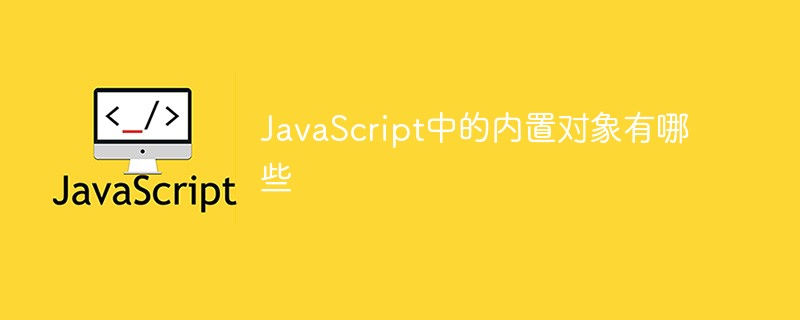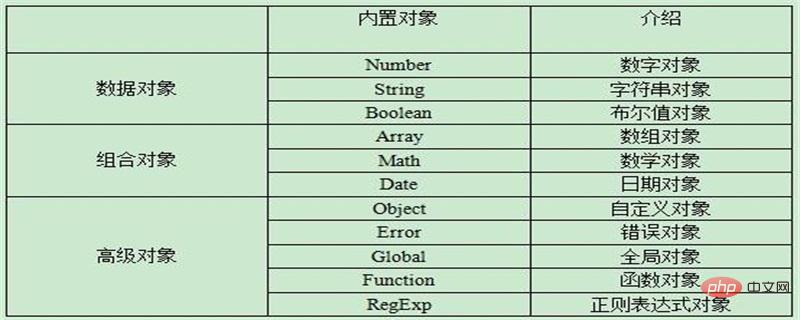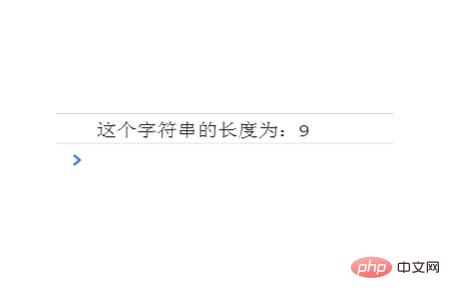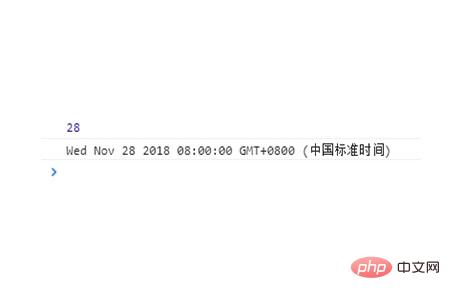What are the built-in objects in JavaScript?
The built-in objects in JavaScript include number, Boolean, String, Data, Array, etc. You can access more methods and properties by creating objects for them in JavaScript.

The operating environment of this article: Windows 7 system, Dell G3 computer, javascript1.8.5.
The built-in objects in JavaScript include number, Boolean, String, Data, Array, etc. You can access more methods and properties by creating objects for them
All the programming languages we learn have built-in Objects, these objects create the basic functionality of the language, so JavaScript also has many intrinsic objects that define it as a language. This article will introduce you to several built-in languages in JavaScript in detail.

Number
Create an object by setting a variable to a numeric value via Number. Then, this variable can access the properties and methods of the object. We can use it in conjunction with the new keyword
var demo=new Number();
The Number object contains four properties:
MAX_VALUE: The maximum number that can be processed
MIN_VALUE: The smallest number that can be processed
NEGATIVE_INFINITY: The largest negative number that can be processed, expressed as -Infinity
POSITIVE_INFINITY: Values greater than MAX_VALUE are expressed as Infinity
Example
var demo = Number.MAX_VALUE
In addition to storing numerical values, the Number object also includes various properties and methods for manipulating or retrieving information about the number. All properties available to Number objects are read-only constants, which means that their values always remain the same and cannot be changed.
Boolean
An object representing a true or false value, usually a variable set to a true or false value:
var demo = true;
Boolean objects include toString And the valueOf method, its combination with conditional statements provides a way to create logic using JavaScript. There is no doubt that Boolean objects are a very important part of JavaScript. Without a Boolean object, there would be nothing to evaluate in the conditional statement.
<script>
var myBoolean = true;
if(myBoolean == true) {
console.log("这是正确的");
}
else {
console.log("这是错误的");
}
</script>
String
The function of the String object in JavaScript is to store text. In addition, the object has various Properties and methods to manipulate information about text. Like the Boolean object, String can be used without instantiation.
var myString = "My string";
The String object has only one attribute length, which is used to return the length of the string.
var myString = "My string";
console.log("这个字符串的长度为:"+myString.length); 
Data
The Date object in JavaScript provides a way to handle dates and times, and it can be instantiated in many different ways depending on the desired results
Example: When no parameters are passed
var myDate = new Date();
Pass milliseconds as a parameter:
var myDate = new Date(milliseconds);
Pass the date string as a parameter:
var myDate = new Date(dateString);
Pass multiple parameters to create a complete Date
var myDate = new Date(year, month, day, hours, minutes, seconds, milliseconds);
Example
var myDate = new Date();
console.log(myDate.getDate())
var myDate1=new Date("2018-11-28");
console.log(myDate1);
There are many methods in the Date object to convert the date into a string,
toDateString: Convert the date part of the Date object into a string
toLocaleDateString: Convert the date part of the Date object into a string according to the local time format
toLocaleTimeString: According to the local time format, convert The time portion of the Date object is converted to a string.
toLocaleString: Convert the Date object to a string according to the local time format.
toTimeString: Convert the time part of the Date object into a string.
toUTCString: Returns the number of milliseconds from January 1, 1970 to the specified date according to universal time.
Example:
var myDate = new Date(); document.write(myDate.toDateString());
Array
The Array object in JavaScript can be used to store multiple values in a variable at the same time, and it There are many ways to operate it.
var myArray = new Array(1, 2, 3);
for(var i=0; i<myArray.length; i++) {
console.log(myArray[i]);
}In addition, there are many methods that can be used for Array objects to add, delete, or sort them. Note that indexes are very important when dealing with arrays. Arrays are basically operated on through indexes.
Summary: The properties and methods provided by JavaScript's built-in objects are just the beginning of the functionality. JavaScript is a flexible language, and we can continue to create new custom functions based on it to make it more powerful.
The above is the detailed content of What are the built-in objects in JavaScript?. For more information, please follow other related articles on the PHP Chinese website!

Hot AI Tools

Undresser.AI Undress
AI-powered app for creating realistic nude photos

AI Clothes Remover
Online AI tool for removing clothes from photos.

Undress AI Tool
Undress images for free

Clothoff.io
AI clothes remover

Video Face Swap
Swap faces in any video effortlessly with our completely free AI face swap tool!

Hot Article

Hot Tools

Notepad++7.3.1
Easy-to-use and free code editor

SublimeText3 Chinese version
Chinese version, very easy to use

Zend Studio 13.0.1
Powerful PHP integrated development environment

Dreamweaver CS6
Visual web development tools

SublimeText3 Mac version
God-level code editing software (SublimeText3)

Hot Topics
 1386
1386
 52
52
 How to implement an online speech recognition system using WebSocket and JavaScript
Dec 17, 2023 pm 02:54 PM
How to implement an online speech recognition system using WebSocket and JavaScript
Dec 17, 2023 pm 02:54 PM
How to use WebSocket and JavaScript to implement an online speech recognition system Introduction: With the continuous development of technology, speech recognition technology has become an important part of the field of artificial intelligence. The online speech recognition system based on WebSocket and JavaScript has the characteristics of low latency, real-time and cross-platform, and has become a widely used solution. This article will introduce how to use WebSocket and JavaScript to implement an online speech recognition system.
 WebSocket and JavaScript: key technologies for implementing real-time monitoring systems
Dec 17, 2023 pm 05:30 PM
WebSocket and JavaScript: key technologies for implementing real-time monitoring systems
Dec 17, 2023 pm 05:30 PM
WebSocket and JavaScript: Key technologies for realizing real-time monitoring systems Introduction: With the rapid development of Internet technology, real-time monitoring systems have been widely used in various fields. One of the key technologies to achieve real-time monitoring is the combination of WebSocket and JavaScript. This article will introduce the application of WebSocket and JavaScript in real-time monitoring systems, give code examples, and explain their implementation principles in detail. 1. WebSocket technology
 How to use JavaScript and WebSocket to implement a real-time online ordering system
Dec 17, 2023 pm 12:09 PM
How to use JavaScript and WebSocket to implement a real-time online ordering system
Dec 17, 2023 pm 12:09 PM
Introduction to how to use JavaScript and WebSocket to implement a real-time online ordering system: With the popularity of the Internet and the advancement of technology, more and more restaurants have begun to provide online ordering services. In order to implement a real-time online ordering system, we can use JavaScript and WebSocket technology. WebSocket is a full-duplex communication protocol based on the TCP protocol, which can realize real-time two-way communication between the client and the server. In the real-time online ordering system, when the user selects dishes and places an order
 How to implement an online reservation system using WebSocket and JavaScript
Dec 17, 2023 am 09:39 AM
How to implement an online reservation system using WebSocket and JavaScript
Dec 17, 2023 am 09:39 AM
How to use WebSocket and JavaScript to implement an online reservation system. In today's digital era, more and more businesses and services need to provide online reservation functions. It is crucial to implement an efficient and real-time online reservation system. This article will introduce how to use WebSocket and JavaScript to implement an online reservation system, and provide specific code examples. 1. What is WebSocket? WebSocket is a full-duplex method on a single TCP connection.
 JavaScript and WebSocket: Building an efficient real-time weather forecasting system
Dec 17, 2023 pm 05:13 PM
JavaScript and WebSocket: Building an efficient real-time weather forecasting system
Dec 17, 2023 pm 05:13 PM
JavaScript and WebSocket: Building an efficient real-time weather forecast system Introduction: Today, the accuracy of weather forecasts is of great significance to daily life and decision-making. As technology develops, we can provide more accurate and reliable weather forecasts by obtaining weather data in real time. In this article, we will learn how to use JavaScript and WebSocket technology to build an efficient real-time weather forecast system. This article will demonstrate the implementation process through specific code examples. We
 Simple JavaScript Tutorial: How to Get HTTP Status Code
Jan 05, 2024 pm 06:08 PM
Simple JavaScript Tutorial: How to Get HTTP Status Code
Jan 05, 2024 pm 06:08 PM
JavaScript tutorial: How to get HTTP status code, specific code examples are required. Preface: In web development, data interaction with the server is often involved. When communicating with the server, we often need to obtain the returned HTTP status code to determine whether the operation is successful, and perform corresponding processing based on different status codes. This article will teach you how to use JavaScript to obtain HTTP status codes and provide some practical code examples. Using XMLHttpRequest
 How to use insertBefore in javascript
Nov 24, 2023 am 11:56 AM
How to use insertBefore in javascript
Nov 24, 2023 am 11:56 AM
Usage: In JavaScript, the insertBefore() method is used to insert a new node in the DOM tree. This method requires two parameters: the new node to be inserted and the reference node (that is, the node where the new node will be inserted).
 JavaScript and WebSocket: Building an efficient real-time image processing system
Dec 17, 2023 am 08:41 AM
JavaScript and WebSocket: Building an efficient real-time image processing system
Dec 17, 2023 am 08:41 AM
JavaScript is a programming language widely used in web development, while WebSocket is a network protocol used for real-time communication. Combining the powerful functions of the two, we can create an efficient real-time image processing system. This article will introduce how to implement this system using JavaScript and WebSocket, and provide specific code examples. First, we need to clarify the requirements and goals of the real-time image processing system. Suppose we have a camera device that can collect real-time image data





